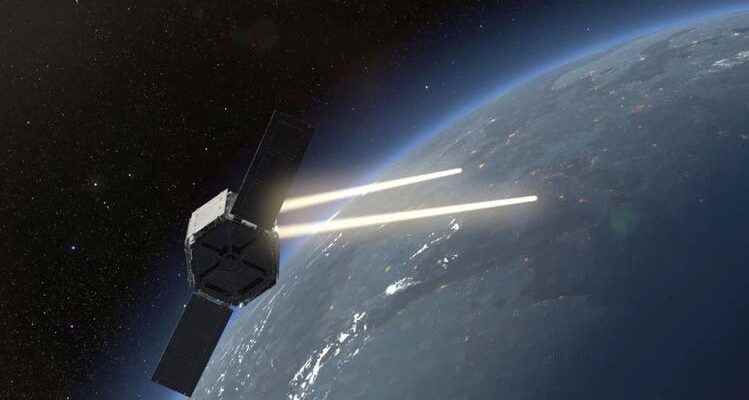ESA wants to send a satellite into low-Earth orbit in 2024. With its help, information can be encrypted extremely securely.
Animated representation of a quantum satellite in contact with two ground stations.
A satellite has been orbiting the earth since 2016, which is viewed with mixed feelings in Europe and the USA. The Chinese quantum satellite called Micius sends specially prepared pulses of light to two distant ground stations, allowing them to exchange a quantum key. This can then be used to encrypt messages and communicate securely. Micius is an integral part of China’s quantum network, which spans a distance of 4,600 kilometers and connects more than 150 nodes. Neither Europe nor the USA have anything comparable to offer.
The fear of cyber attacks has now prompted Europe to do more for its own digital security. The European Space Agency (ESA) has the satellite operator SES in Luxembourg awarded the contract to build a quantum satellite, which is to be launched into space in 2024. Its name is Eagle-1. SES will lead a consortium of 20 European companies. The project is financially supported by the European Commission.
Switzerland is also involved in the construction of the satellite through its ESA membership. The Geneva-based company Id Quantique will contribute a quantum random number generator that it has developed. However, since Switzerland is no longer an associated EU member, the EU insists that a second quantum random number generator be developed. This is how she wants to preserve her strategic autonomy.
Light quanta cannot be intercepted
The security of a quantum key is based on the fact that individual light particles cannot be intercepted and measured without changing their state. If the sender and receiver of the photons follow a specific protocol, they can determine whether they have been intercepted. In this case, they discard the key and generate a new one. Information is only encrypted and decrypted with it when the security of the key is guaranteed.
The problem with quantum cryptography is that key exchange on the ground only works over limited distances. The unavoidable losses in a fiber optic cable mean that after a distance of one hundred kilometers hardly a photon reaches the receiver. That is why there are quantum networks in Europe today that connect different nodes in a metropolis. But a transnational exchange of quantum keys over thousands of kilometers is still not possible in Europe.
At least since 2007 it has been clear that you have to go into space if you want to overcome the length limitation. At that time, European researchers exchanged a quantum key between two Canary Islands. The photons covered a distance in the air of 144 kilometers back. This marked the next step: a satellite that orbits the earth in a low-earth orbit and from there sends photons to two ground stations.
In the years that followed, research continued in Europe, and ideas for a space mission also arose. But the political will to implement them was lacking. The shock was all the greater when China took the initiative. Under the leadership of the quantum researcher Jian-Wei Pan, who received his doctorate in Austria, a satellite for quantum scientific experiments was developed and launched in 2016.
What Jian-Wei Pan’s team has achieved since then commands respect from scientists around the world. Micius is a miracle, says Harald Weinfurter from the LMU in Munich, who was involved in the groundbreaking experiment on the Canary Islands. A video conference between Beijing and Vienna in 2018 attracted worldwide attention. This was encoded with a quantum key that the two parties had previously generated using Micius.
Specialized in quantum key exchange
The Eagle 1 satellite that SES is now building for ESA will not be quite as versatile as its Chinese counterpart. While Micius has conducted a slew of quantum science experiments over the past few years, Eagle-1 specializes in quantum key exchanges. However, he should do this task more efficiently than Micius. Eagle-1 should generate more quantum bits per second and thus generate longer quantum keys.
It is planned that Eagle-1 will complete a three-year test phase after its launch. During this time, the satellite will communicate with an existing ground station in Germany and a station still to be built in the Netherlands. Further ground stations in other countries are to be added later.
In parallel, within the framework of European quantum communication infrastructure initiative the terrestrial segment of the quantum network will also be expanded. The long-term goal is a transnational quantum network that is to be integrated into the existing European communication network. In this way, Europe wants to ensure that its critical infrastructure is protected in the best possible way.
Follow the science editors of the NZZ Twitter.
